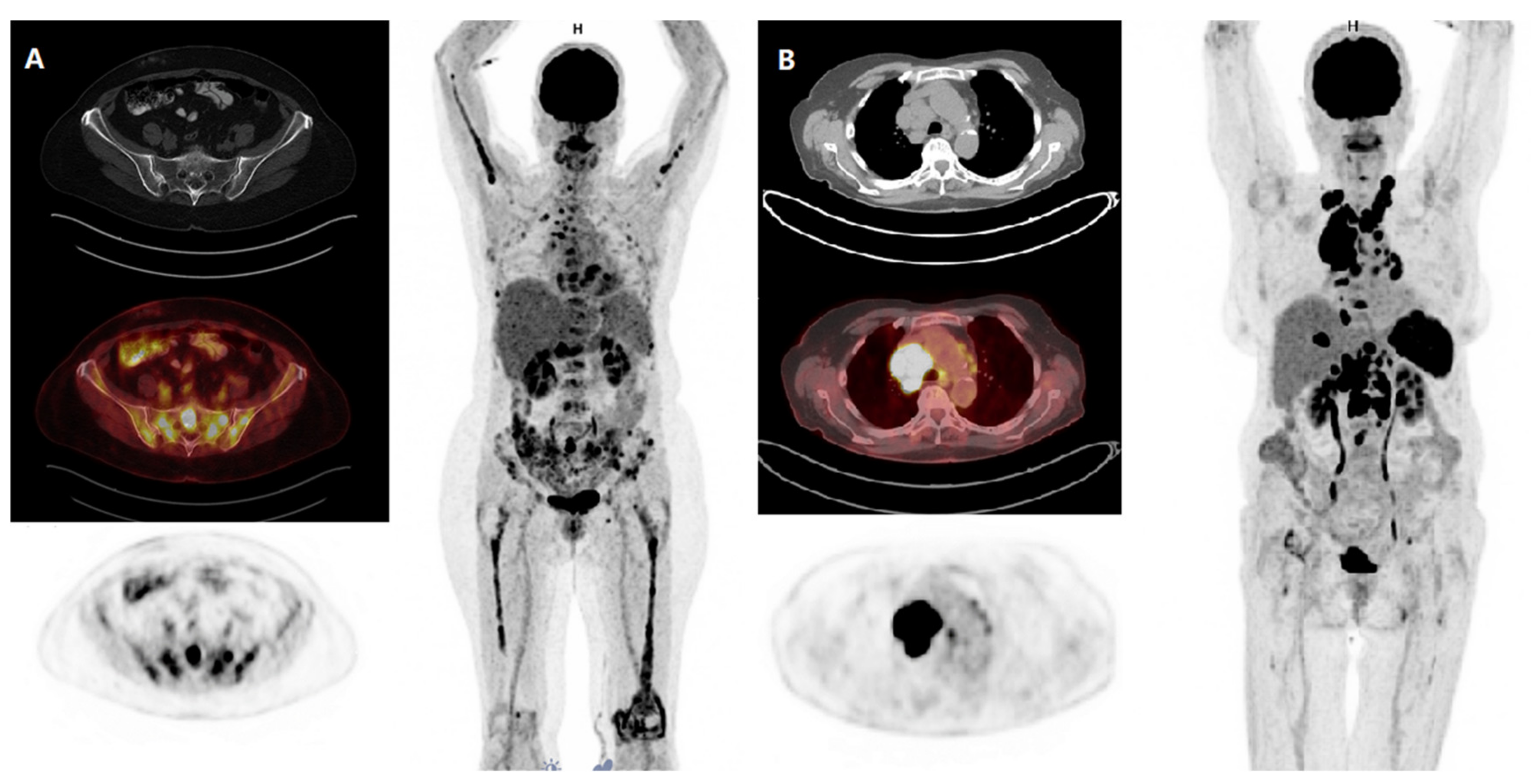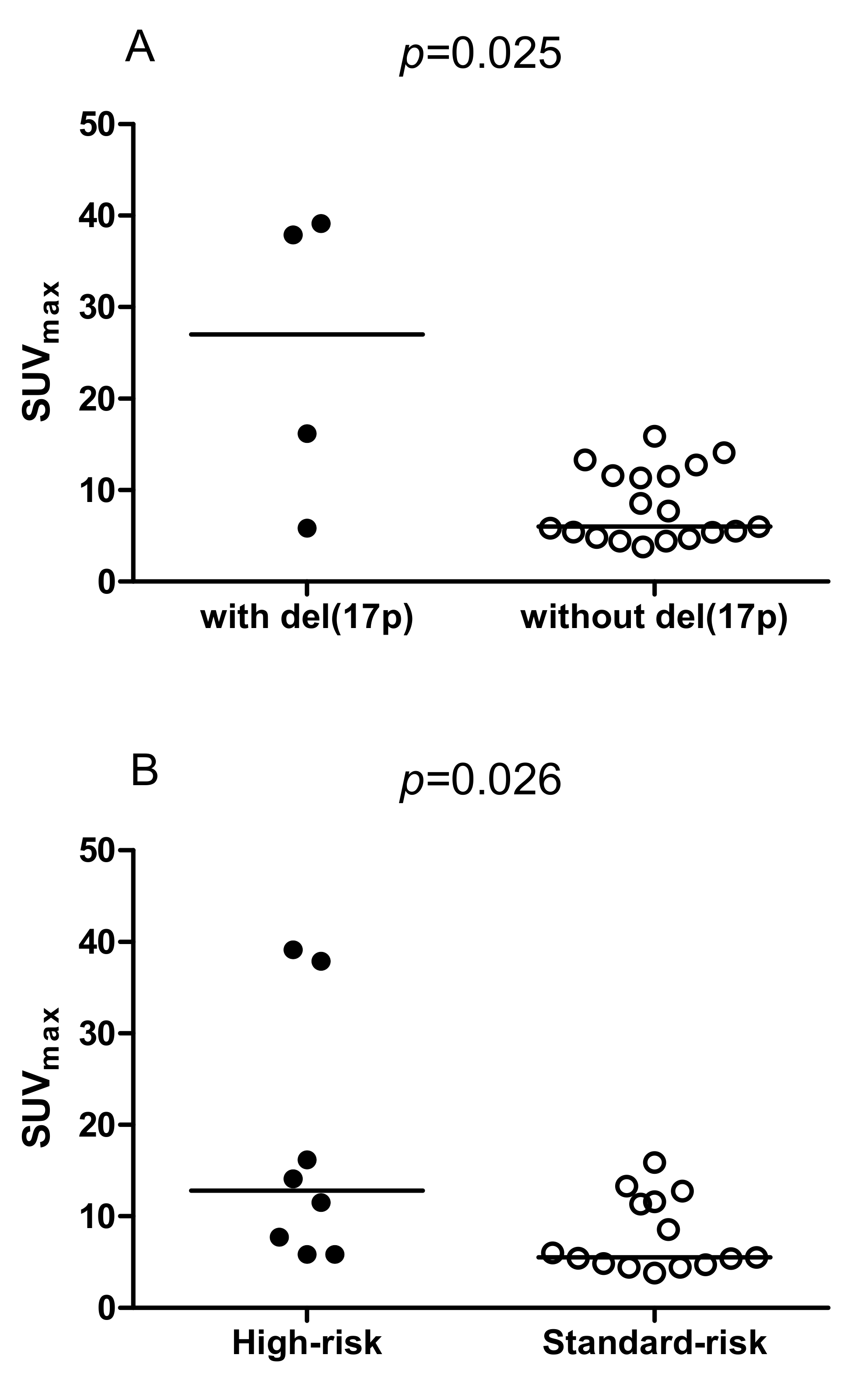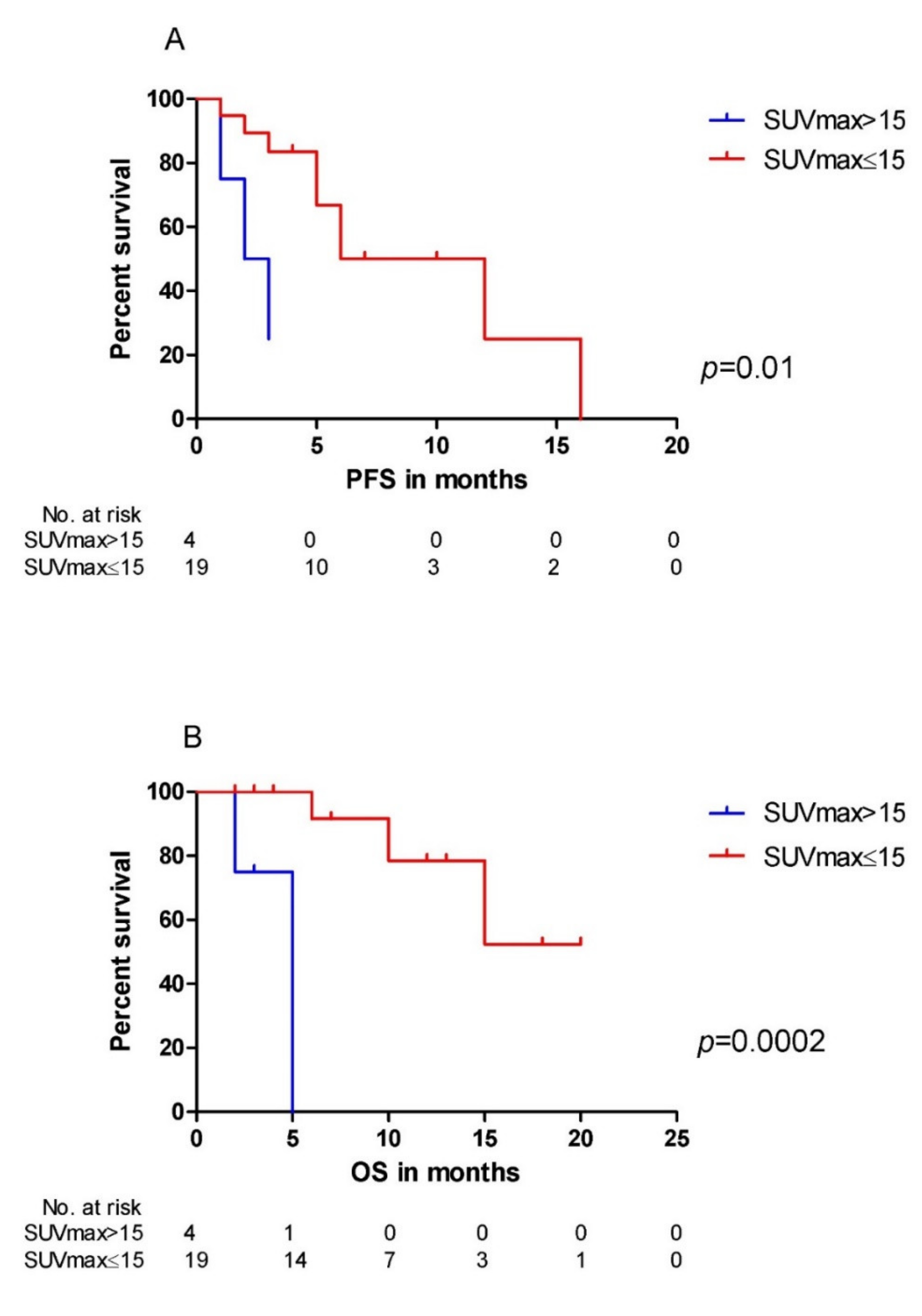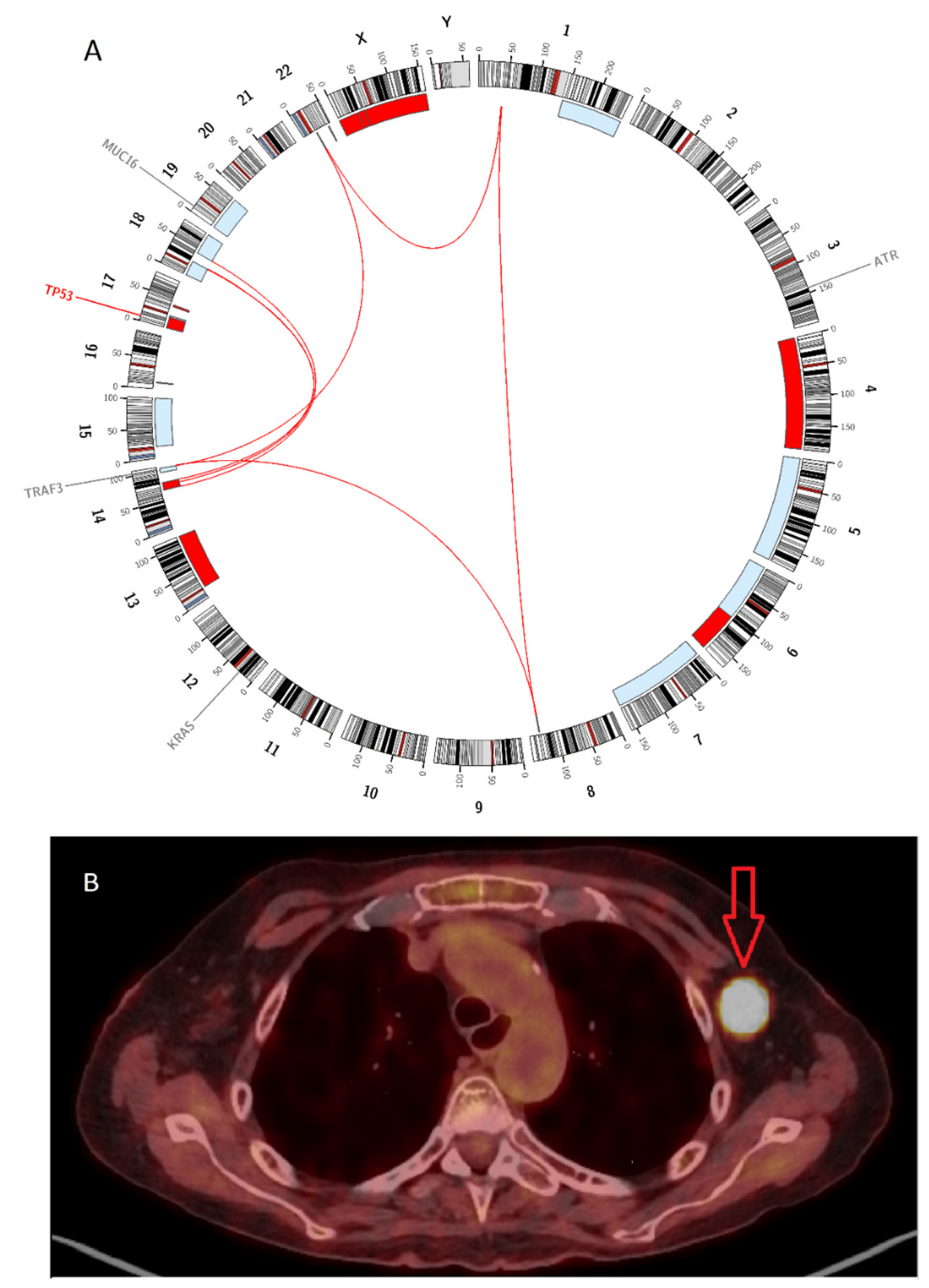The Link between Cytogenetics/Genomics and Imaging Patterns of Relapse and Progression in Patients with Relapsed/Refractory Multiple Myeloma: A Pilot Study Utilizing 18F-FDG PET/CT
Abstract
1. Introduction
2. Methods
2.1. Patient Population
2.2. Imaging Analysis, Cytogenetics, and Genomic Data
2.3. Statistical Analysis
3. Results
3.1. Patients’ Characteristics
3.2. Patterns of Relapse and Progression
3.3. Cytogenetics and Imaging Patterns of Relapse and Progression
3.4. WGS and Imaging Patterns of Relapse and Progression
4. Discussion
5. Conclusions
Supplementary Materials
Author Contributions
Funding
Conflicts of Interest
References
- Robak, P.; Drozdz, I.; Szemraj, J.; Robak, T. Drug resistance in multiple myeloma. Cancer Treat. Rev. 2018, 70, 199–208. [Google Scholar] [CrossRef] [PubMed]
- Cavo, M.; Terpos, E.; Nanni, C.; Moreau, P.; Lentzsch, S.; Zweegman, S.; Hillengass, J.; Engelhardt, M.; Usmani, S.Z.; Vesole, D.H.; et al. Role of (18)F-FDG PET/CT in the diagnosis and management of multiple myeloma and other plasma cell disorders: A consensus statement by the International Myeloma Working Group. Lancet Oncol. 2017, 18, e206–e217. [Google Scholar] [CrossRef]
- Stolzenburg, A.; Luckerath, K.; Samnick, S.; Speer, M.; Kneer, K.; Schmid, J.S.; Grigoleit, G.U.; Hofmann, S.; Beer, A.J.; Bunjes, D.; et al. Prognostic value of [(18)F]FDG-PET/CT in multiple myeloma patients before and after allogeneic hematopoietic cell transplantation. Eur. J. Nucl. Med. Mol. Imaging 2018, 45, 1694–1704. [Google Scholar] [CrossRef] [PubMed]
- Mai, E.K.; Hielscher, T.; Kloth, J.K.; Merz, M.; Shah, S.; Hillengass, M.; Wagner, B.; Hose, D.; Raab, M.S.; Jauch, A.; et al. Association between magnetic resonance imaging patterns and baseline disease features in multiple myeloma: Analyzing surrogates of tumour mass and biology. Eur. Radiol. 2016, 26, 3939–3948. [Google Scholar] [CrossRef]
- Rasche, L.; Angtuaco, E.J.; Alpe, T.L.; Gershner, G.H.; McDonald, J.E.; Samant, R.S.; Kumar, M.; Van Hemert, R.; Epstein, J.; Deshpande, S.; et al. The presence of large focal lesions is a strong independent prognostic factor in multiple myeloma. Blood 2018, 132, 59–66. [Google Scholar] [CrossRef]
- McDonald, J.E.; Kessler, M.M.; Gardner, M.W.; Buros, A.F.; Ntambi, J.A.; Waheed, S.; van Rhee, F.; Zangari, M.; Heuck, C.J.; Petty, N.; et al. Assessment of Total Lesion Glycolysis by (18)F FDG PET/CT Significantly Improves Prognostic Value of GEP and ISS in Myeloma. Clin. Cancer Res. 2017, 23, 1981–1987. [Google Scholar] [CrossRef]
- Rajkumar, S.V.; Harousseau, J.L.; Durie, B.; Anderson, K.C.; Dimopoulos, M.; Kyle, R.; Blade, J.; Richardson, P.; Orlowski, R.; Siegel, D.; et al. Consensus recommendations for the uniform reporting of clinical trials: Report of the International Myeloma Workshop Consensus Panel 1. Blood 2011, 117, 4691–4695. [Google Scholar] [CrossRef]
- Palumbo, A.; Avet-Loiseau, H.; Oliva, S.; Lokhorst, H.M.; Goldschmidt, H.; Rosinol, L.; Richardson, P.; Caltagirone, S.; Lahuerta, J.J.; Facon, T.; et al. Revised International Staging System for Multiple Myeloma: A Report From International Myeloma Working Group. J. Clin. Oncol. 2015, 33, 2863–2869. [Google Scholar] [CrossRef]
- Kinahan, P.E.; Fletcher, J.W. Positron emission tomography-computed tomography standardized uptake values in clinical practice and assessing response to therapy. Semin. Ultrasound CT MR 2010, 31, 496–505. [Google Scholar] [CrossRef]
- Jamet, B.; Bailly, C.; Carlier, T.; Planche, L.; Touzeau, C.; Kraeber-Bodere, F.; Moreau, P.; Bodet-Milin, C. Added prognostic value of FDG-PET/CT in relapsing multiple myeloma patients. Leuk. Lymphoma 2019, 60, 222–225. [Google Scholar] [CrossRef]
- Lapa, C.; Luckerath, K.; Malzahn, U.; Samnick, S.; Einsele, H.; Buck, A.K.; Herrmann, K.; Knop, S. 18 FDG-PET/CT for prognostic stratification of patients with multiple myeloma relapse after stem cell transplantation. Oncotarget 2014, 5, 7381–7391. [Google Scholar] [CrossRef] [PubMed]
- Abe, Y.; Sunami, K.; Yamashita, T.; Ueda, M.; Takamatsu, H.; Narita, K.; Kobayashi, H.; Kitadate, A.; Takeuchi, M.; Matsue, K. Improved survival outcomes and relative youthfulness of multiple myeloma patients with t(4;14) receiving novel agents are associated with poorer performance of the revised international staging system in a real aging society. Oncotarget 2019, 10, 595–605. [Google Scholar] [CrossRef] [PubMed]
- Zamagni, E.; Patriarca, F.; Nanni, C.; Zannetti, B.; Englaro, E.; Pezzi, A.; Tacchetti, P.; Buttignol, S.; Perrone, G.; Brioli, A.; et al. Prognostic relevance of 18-F FDG PET/CT in newly diagnosed multiple myeloma patients treated with up-front autologous transplantation. Blood 2011, 118, 5989–5995. [Google Scholar] [CrossRef] [PubMed]
- Besse, L.; Sedlarikova, L.; Greslikova, H.; Kupska, R.; Almasi, M.; Penka, M.; Jelinek, T.; Pour, L.; Adam, Z.; Kuglik, P.; et al. Cytogenetics in multiple myeloma patients progressing into extramedullary disease. Eur. J. Haematol. 2016, 97, 93–100. [Google Scholar] [CrossRef] [PubMed]
- Rasche, L.; Bernard, C.; Topp, M.S.; Kapp, M.; Duell, J.; Wesemeier, C.; Haralambieva, E.; Maeder, U.; Einsele, H.; Knop, S. Features of extramedullary myeloma relapse: High proliferation, minimal marrow involvement, adverse cytogenetics: A retrospective single-center study of 24 cases. Ann. Hematol. 2012, 91, 1031–1037. [Google Scholar] [CrossRef]
- Levine, A.J.; Momand, J.; Finlay, C.A. The p53 tumour suppressor gene. Nature 1991, 351, 453–456. [Google Scholar] [CrossRef]
- Bouaoun, L.; Sonkin, D.; Ardin, M.; Hollstein, M.; Byrnes, G.; Zavadil, J.; Olivier, M. TP53 Variations in Human Cancers: New Lessons from the IARC TP53 Database and Genomics Data. Hum. Mutat. 2016, 37, 865–876. [Google Scholar] [CrossRef]
- Baralle, D.; Baralle, M. Splicing in action: Assessing disease causing sequence changes. J. Med. Genet. 2005, 42, 737–748. [Google Scholar] [CrossRef]
- Rasche, L.; Angtuaco, E.; McDonald, J.E.; Buros, A.; Stein, C.; Pawlyn, C.; Thanendrarajan, S.; Schinke, C.; Samant, R.; Yaccoby, S.; et al. Low expression of hexokinase-2 is associated with false-negative FDG-positron emission tomography in multiple myeloma. Blood 2017, 130, 30–34. [Google Scholar] [CrossRef]
- Kitamura, S.; Yanagi, T.; Inamura-Takashima, Y.; Imafuku, K.; Hata, H.; Uehara, J.; Ishida, Y.; Otsuka, A.; Hirata, K.; Shimizu, H. Retrospective study on the correlation between 18-fluorodeoxyglucose uptake in positron emission tomography-computer tomography and tumour volume, cytological activity as assessed with Ki-67 and GLUT-1 staining in 10 cases of Merkel cell carcinoma. J. Eur. Acad. Dermatol. Venereol. 2018, 32, e285–e287. [Google Scholar] [CrossRef]
- Martin, O.; Aissa, J.; Boos, J.; Wingendorf, K.; Latz, D.; Buchbender, C.; Gaspers, S.; Antke, C.; Sedlmair, M.; Antoch, G.; et al. Impact of different metal artifact reduction techniques on attenuation correction in 18F-FDG PET/CT examinations. Br. J. Radiol. 2020, 93, 20190069. [Google Scholar] [CrossRef] [PubMed]
- Rabkin, Z.; Israel, O.; Keidar, Z. Do hyperglycemia and diabetes affect the incidence of false-negative 18F-FDG PET/CT studies in patients evaluated for infection or inflammation and cancer? A Comparative analysis. J. Nucl. Med. 2010, 51, 1015–1020. [Google Scholar] [CrossRef] [PubMed]
- Lapa, C.; Garcia-Velloso, M.J.; Luckerath, K.; Samnick, S.; Schreder, M.; Otero, P.R.; Schmid, J.S.; Herrmann, K.; Knop, S.; Buck, A.K.; et al. (11)C-Methionine-PET in Multiple Myeloma: A Combined Study from Two Different Institutions. Theranostics 2017, 7, 2956–2964. [Google Scholar] [CrossRef] [PubMed]
- Lapa, C.; Knop, S.; Schreder, M.; Rudelius, M.; Knott, M.; Jorg, G.; Samnick, S.; Herrmann, K.; Buck, A.K.; Einsele, H.; et al. 11C-Methionine-PET in Multiple Myeloma: Correlation with Clinical Parameters and Bone Marrow Involvement. Theranostics 2016, 6, 254–261. [Google Scholar] [CrossRef] [PubMed]
- Lapa, C.; Schreder, M.; Schirbel, A.; Samnick, S.; Kortum, K.M.; Herrmann, K.; Kropf, S.; Einsele, H.; Buck, A.K.; Wester, H.J.; et al. [(68)Ga]Pentixafor-PET/CT for imaging of chemokine receptor CXCR4 expression in multiple myeloma—Comparison to [(18)F]FDG and laboratory values. Theranostics 2017, 7, 205–212. [Google Scholar] [CrossRef]
- Pan, Q.; Cao, X.; Luo, Y.; Li, J.; Feng, J.; Li, F. Chemokine receptor-4 targeted PET/CT with (68)Ga-Pentixafor in assessment of newly diagnosed multiple myeloma: Comparison to (18)F-FDG PET/CT. Eur. J. Nucl. Med. Mol. Imaging 2020, 47, 537–546. [Google Scholar] [CrossRef]
- Rasche, L.; Chavan, S.S.; Stephens, O.W.; Patel, P.H.; Tytarenko, R.; Ashby, C.; Bauer, M.; Stein, C.; Deshpande, S.; Wardell, C.; et al. Spatial genomic heterogeneity in multiple myeloma revealed by multi-region sequencing. Nat. Commun. 2017, 8, 268. [Google Scholar] [CrossRef]




| Parameter | Number |
|---|---|
| Patients, n | 24 |
| Gender, n (%) | |
| Male | 14 (58) |
| Female | 10 (42) |
| Age at the last relapse/progression, median (range), years | 68 (46–81) |
| Subtype, n (%) | |
| IgG | 16 (67) |
| IgA | 7 (29) |
| LC | 1 (4) |
| ISS Stage, n (%) | |
| I | 9 (37) |
| II | 5 (21) |
| III | 5 (21) |
| NA | 5 (21) |
| Cytogenetics, n (%) | |
| High-risk | 8 (33) |
| Standard-risk | 15 (63) |
| NA | 1 (4) |
| t(4;14) | |
| Yes | 5 (21) |
| No | 18 (75) |
| NA | 1 (4) |
| t(14;16) | |
| Yes | 1 (4) |
| No | 19 (79) |
| NA | 4 (17) |
| del(17p) | |
| Yes | 4 (17) |
| No | 19 (79) |
| NA | 1 (4) |
| gain(1q21) | |
| Yes | 10 (42) |
| No | 13 (54) |
| NA | 1 (4) |
| EMD at diagnosis, n (%) | |
| Yes | 5 (21) |
| No | 19 (79) |
| Prior lines of therapy, n (%) | |
| 2–1 month | 9 (38) |
| 4–3 month | 7 (29) |
| ≥5 | 8 (33) |
| Prior treatments, n (%) | |
| PIs | |
| Bortezomib | 24 (100) |
| Carfilzomib | 10 (42) |
| IMiDs | |
| Lenalidomide | 20 (83) |
| Pomalidomide | 7 (29) |
| Thalidomide | 3 (13) |
| Monoclonal antibodies | |
| Daratumumab | 13 (54) |
| Elotuzumab | 2 (8) |
| SCT | |
| Prior autologous SCT | 23 (96) |
| Prior allogenic SCT | 3 (13) |
| BCMA-directed novel immunotherapies within clinical trials | |
| Bispecific antibody | 2 (8) |
| CAR-T-cell | 1 (4) |
| Drug resistance, n (%) | |
| Bortezomib | 8 (33) |
| Carfilzomib | 9 (38) |
| Lenalidomide | 14 (58) |
| Pomalidomide | 6 (25) |
| Daratumumab | 11 (46) |
| Parameter | Number |
|---|---|
| Patients, n | 24 |
| Serological activity, n (%) | |
| Yes | 22 (92) |
| No | 2 (8) |
| Bone marrow infiltration, n (%) | |
| <10% | 4 (17) |
| ≥10% | 17 (71) |
| NA | 3 (12) |
| Laboratory parameters, n (%) | |
| eGFR, mL/min (CKD-EPI), median (range) | 70 (34–98) |
| ≥50 mL/min | 18 (75) |
| <50 mL/min | 6 (25) |
| Calcium, mmol/L, median (range) | 2.5 (2.0–2.3) |
| ≥2.5 mmol/L | 0 (0) |
| <2.5 mmol/L | 24 (100) |
| LDH, U/L, median (range) | 197 (107–711) |
| ≥250 U/L | 7 (29) |
| <250 U/L | 17 (71) |
| Hemoglobin, g/dL, median (range) | 11.0 (7.7–14.3) |
| ≥10 g/dL | 16 (67) |
| <10 g/dL | 8 (33) |
| β2-microglobulin, mg/L, median (range) | 3.6 (1.7–9.7) |
| ≥3.5 mg/L | 13 (54) |
| <3.5 mg/L | 11 (46) |
| Number of medullary lesions, n (%) | |
| 0 | 1 (4) |
| 3–1 month | 6 (25) |
| 7–4 month | 2 (8) |
| >7 | 15 (63) |
| Number of EMD, n (%) | |
| 0 | 18 (75) |
| 3–1 month | 4 (17) |
| 7–4 month | 1 (4) |
| >7 | 1 (4) |
| Localization of EMD, n (%) | |
| Lymph node | 3 (12) |
| Parenchymal organ | 2 (8) |
| Soft tissue | 1 (4) |
| SUVmax, median (range) | 8.15 (3.81–39.14) |
| Localization of the hottest lesion, n (%) | |
| Medullary | 22 (92) |
| Extramedullary | 2 (8) |
| Comparison between DWMRI and 18F-FDG-PET/CT (n = 6), n (%) | |
| Number of DWI positive lesions > FDG avid lesions | 2 (33) |
| Number of DWI positive lesions < FDG avid lesions | 1 (17) |
| Number of DWI positive lesions = FDG avid lesions | 3 (50) |
| Patient | Gender | Age at Diagnosis | Subtype | Lines of Prior Therapy | Mutated Genes | High-Risk Structural Alterations | SUVmax | EMD | Size of the Largest EMD, cm | Localization of the Largest EMD |
|---|---|---|---|---|---|---|---|---|---|---|
| 1 | M | 54 | IgA Kappa | 5 | KRAS | None | 5.4 | No | / | / |
| 2 | F | 75 | IgG Kappa | 3 | KRAS, CUL4B | None | 12.78 | Yes | 2.6 | Lymph node |
| 3 | M | 48 | IgG Kappa | 3 | BRAF | None | 4.44 | No | / | / |
| 4 | M | 78 | IgG Kappa | 1 | None | None | 8.58 | No | / | / |
| 5 | F | 60 | IgG Kappa | 7 | TP53 | del(17p), gain(1q21) | 37.88 | Yes | 3.1 | Lymph node |
| 6 | M | 66 | IgA Kappa | 2 | KRAS, MUC16, NRAS, RRBP1, FAM46C | gain(1q21) | 11.36 | No | / | / |
| 7 | F | 64 | IgA Kappa | 8 | KRAS | gain(1q21) | 6.04 | No | / | / |
| 8 | F | 74 | IgA Lambda | 2 | None | t(14;16), gain(1q21) | 7.73 | No | / | / |
| 9 | M | 72 | Kappa LC | 1 | NRAS | gain(1q21) | 13.31 | No | / | / |
© 2020 by the authors. Licensee MDPI, Basel, Switzerland. This article is an open access article distributed under the terms and conditions of the Creative Commons Attribution (CC BY) license (http://creativecommons.org/licenses/by/4.0/).
Share and Cite
Zhou, X.; Dierks, A.; Kertels, O.; Samnick, S.; Kircher, M.; Buck, A.K.; Haertle, L.; Knorz, S.; Böckle, D.; Scheller, L.; et al. The Link between Cytogenetics/Genomics and Imaging Patterns of Relapse and Progression in Patients with Relapsed/Refractory Multiple Myeloma: A Pilot Study Utilizing 18F-FDG PET/CT. Cancers 2020, 12, 2399. https://doi.org/10.3390/cancers12092399
Zhou X, Dierks A, Kertels O, Samnick S, Kircher M, Buck AK, Haertle L, Knorz S, Böckle D, Scheller L, et al. The Link between Cytogenetics/Genomics and Imaging Patterns of Relapse and Progression in Patients with Relapsed/Refractory Multiple Myeloma: A Pilot Study Utilizing 18F-FDG PET/CT. Cancers. 2020; 12(9):2399. https://doi.org/10.3390/cancers12092399
Chicago/Turabian StyleZhou, Xiang, Alexander Dierks, Olivia Kertels, Samuel Samnick, Malte Kircher, Andreas K. Buck, Larissa Haertle, Sebastian Knorz, David Böckle, Lukas Scheller, and et al. 2020. "The Link between Cytogenetics/Genomics and Imaging Patterns of Relapse and Progression in Patients with Relapsed/Refractory Multiple Myeloma: A Pilot Study Utilizing 18F-FDG PET/CT" Cancers 12, no. 9: 2399. https://doi.org/10.3390/cancers12092399
APA StyleZhou, X., Dierks, A., Kertels, O., Samnick, S., Kircher, M., Buck, A. K., Haertle, L., Knorz, S., Böckle, D., Scheller, L., Messerschmidt, J., Barakat, M., Truger, M., Haferlach, C., Einsele, H., Rasche, L., Kortüm, K. M., & Lapa, C. (2020). The Link between Cytogenetics/Genomics and Imaging Patterns of Relapse and Progression in Patients with Relapsed/Refractory Multiple Myeloma: A Pilot Study Utilizing 18F-FDG PET/CT. Cancers, 12(9), 2399. https://doi.org/10.3390/cancers12092399







